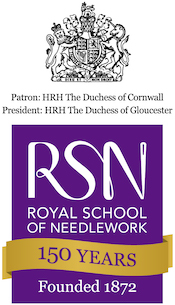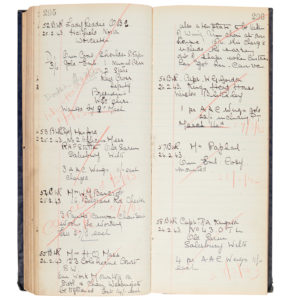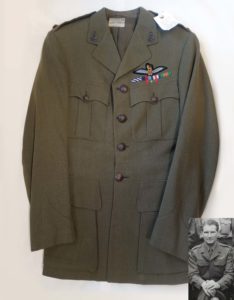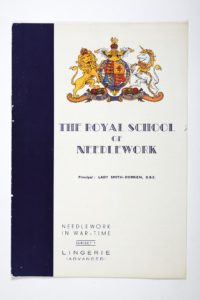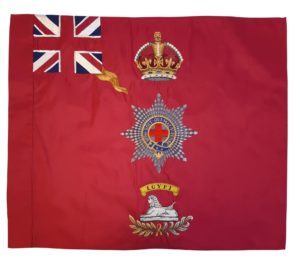With Honour
150 Years of the RSN: Virtual Exhibition
The RSN began working on military colours in the nineteenth century, originally conserving them, then making new sets, and this continued through into recent times. Today, the RSN is probably the only place that teaches the ‘Both Sides Alike’ technique, whereby the stitcher embellishes the front and the back of the single piece of banner silk simultaneously, to look exactly the same.
During the First World War, the RSN designed kits for returning soldiers and sailors to work as part of their occupational therapy, as it was recognised that embroidery can allow other parts of the mind and body to relax and to heal. This continued in the Second World War when Lady Smith-Dorrien sent out a press release to all allied countries entreating people not to knit but to stitch for better mental health. She realised that good knitters could work almost on autopilot, but that embroiderers needed to focus on the stitch, which eased other parts of the body, making it a more therapeutic activity.
During the Second World War the RSN embarked on two specific programmes. The first was a series of kits for people to stitch their own regimental badge. Starting with the British regiments, by the end it included all the allied forces. Many of the kits were taken to prisoners of war by the Red Cross for them to work. Secondly, the RSN published a practical series called Needlework in War Time, which was promoted as a correspondence course to encourage more people to make their own clothes. However, it had a rather eccentric order, beginning with lingerie, and it was only after the War Office stepped in that the remodelling and reuse of items were added.
Army Air Observation Post Badge
1941
Hand embroidered in silks
Prototype of a badge for the newly formed Air Observation Post. Ordered by Capt. Ingram (inset), later Major. Ingram was asked to design a flying badge for Air OP Squadron pilots in early 1941. A small number of these were made up by the Royal School of Needlework (see RSN order book for 15/9/41 and 11/11/41). The badge comprises wings, along with the ‘flaming grenade’ badge and ‘Ubique’ motto of the Royal Artillery. (Ubique means ‘everywhere’). The flying badge design was submitted to the War Office for consideration for use by Air OP pilots but, at this time, soldiers were also being trained to be glider pilots. The War Office was anxious to have just one, common, flying badge for all Army soldiers who qualified as pilots, so the prototype Air OP badge was not approved. In 1942, a wings badge with the Royal Crest (lion and crown) was chosen instead for all Army pilots. The RSN went on to make many of the badges, always wanted urgently.
On loan from the Army Flying Museum
Therapeutic Stitch
1939-46
Stitching design based on the regimental kits
Based on what the RSN and Lady Smith-Dorrien had observed in the First World War, stitch was actively promoted by the RSN as occupational therapy. Stitching kits had been produced in conjunction with Wm Briggs and Co and approved by the War Office for all allied regiments. These badges could be stitched by people at home but were also distributed by the Red Cross to prisoners of War. The canvases being ‘worked’ by the recuperating soldiers are from the RSN archive and the stitching is by Anne-Marie Gates and Sue Miller. The three regimental badges works-in-progress are stitched by Susan Walton, Joanna Gration and Julian Keeley.
Regimental Stitch Pack
1940s
Cellophane, paper, transfer paper, and magazine where first advertised.
A kit was made for every regiment in the allied forces by the end of the war and the prototype badge for each kit was stitched by the RSN but none of these remain in the Collection. Inside the pack were instructions and transfers of the design in two sizes. When first launched it was suggested that the designs could be used in domestic settings, such as for a Radio Times cover.
Workbook with Orders for Badges
1942
Hard bound ledger
It is clear from the workbooks that the RSN made many badges for both the Glider Corps and the Observer Corps. From the speed of delivery it would appear the RSN had a pipeline of them so that any order could be at least partially fulfilled the minute it was received.
Service Dress Jacket with Air Observation Post Insignia
1943
Cotton
The jacket belonged to Major Andrew Lyell DFC CdeG RA (inset). In June 1940, he volunteered for the Air OP Squadrons, attending No.2 training course in 1941. From February until April 1942, Lyell trained to be an Elementary Flying Instructor, qualifying on 7/4/1942. He ordered his wings from the RSN on 19/05/1942 and recalled “It was, I believe, sometime in the spring of 1942 that we at last got Air OP wings.” In 1943, Lyell was ordered to form No.658 Air OP Squadron RAF. He commanded the unit until after the end of the war. During the war, Lyell was awarded a Distinguished Flying Cross and the Croix de Guerre.
On loan from the Army Flying Museum
Panel Based on Overlord Embroidery Panel 28
c1974
Canvas work panel in wool
This stand-alone panel was worked by Selina Winter of the RSN once the main work on the Overlord Embroidery was completed in 1974. The Overlord Embroidery was commissioned by Lord Dulverton to commemorate the D Day landings of the allied forces in France on 6 June 1944. The RSN spent six years working on the 34 panels that tell this story under the guidance of Head of the Workroom Margaret Bartlett. The panels can be seen at the D Day Story, Portsmouth.
On loan from the D Day Story Museum/Overlord Trust
